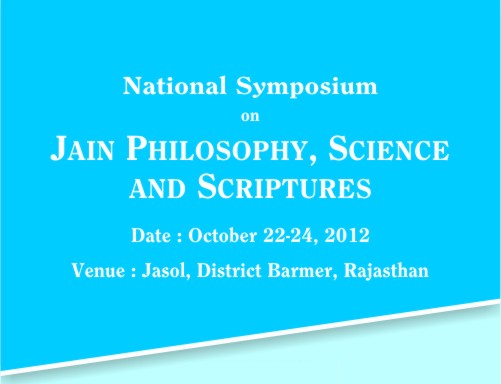
National Symposium on Jain Philosophy, Science And Scriptures
A Case For Producing New Jain Literatre To Meet Today’s Needs
Dr. Sulekh C. Jain and Dilip V. Shah
Notewe are presenting this paper as a dialog to start a serious, rational and critical discussion with open minds about the status and availability of literature on Jain dharma. To create any good debate, many a times one may be critical of the present state of affairs. This is very necessary otherwise “if we always do what we always did, then we will always get what we always got”; which means status quo”. Still if any one feels hurt, we say Michchami Dukkadam.
Jain Dharma
Jain dharma, an ancient religion originating from India- with Hinduism and Buddhism- is an integral part of India. The Jain tradition, which enthroned the philosophy of ecological harmony and non-violence as its lodestar, flourished for centuries side-by-side with other schools of thought in ancient India. It formed a vital part of the mainstream of ancient Indian life, contributing greatly to its philosophical, artistic and political heritage. During certain periods of Indian history, many ruling elites as well as large sections of the population were Jains.
Although the Eight to ten million Jains estimated to live in modern India, constitute a tiny fraction of its population, the message and motifs of the Jain perspective, its unconditional reverence for life in all forms, its commitment to the progress of human civilization and to the preservation of the natural environment, continues to have profound and pervasive influence on Indian life and outlook. Jainism, with its distinctive views on matters such as non-violence and intellectual relativity, has relevance to the life and thought of not only of this century but also for many centuries to come.
Jain Dharma has succeeded in preserving to the present time its integrity as a separate system in the midst of preponderant Hinduism. Jain Dharma is a complete system with all necessary branches such as ontology, metaphysics, philosophy, epistemology, ethics, rituals etc. It has its own scriptures, temples (architecturally, some of the most beautiful temples in India are the Jain temples) and deities, places of worship and pilgrimage, and its own festivals and fairs. The organized religious group (Sangh) consists of ascetics and householders of both genders.
Jainism was not founded by any one individual. It is a philosophy, which developed over a long period of time and then acquired its own distinctive status within the broad Indian system. Its latest omniscient and tirthankar, Bhagwan MAHAVIR, was a contemporary of Lord Buddha and 2600 years ago he lived in the same Indian state of modern Bihar, as did Lord Buddha. Bhagwan Mahavir’s life and teachings exerted a great influence on the Indian thoughts and a way of life.
Jains have been around for thousands of years, are the most educated and affluent community and its more than 14,000 monks and nuns who are also very educated and austere, stand out as the most dynamic, and vibrant community in the entire Indian subcontinent. Yet, it is a sad fact that in spite of this, Jains are least known and most mis-understood amongst most of the major world religions. Let us share below some of the observations that we have collected over the years about Jain Dharma and the Jain Community.
Present Perception About Jain Dharma & The Jain Community
Jainism is least known, and most misunderstood. We have read several most recently published books on world religions that either completely ignore/omit Jainism or mention that Jainism is an obscure and insignificant religion in India. Still many Westerners wrongly think and believe (and even some Hindus say) that Jainism is part of or an offshoot of Hinduism.
In a post graduate teaching class in USA, one professor who regularly teaches Hinduism and Jainism asked his students why there is not much interest in Jain studies. The response was that “Jains mostly live in the past and other worldliness and notenough literature is available about common lay people; whatever is available is mostly about monks and nuns and their life styles, as a result it has little relevance in 21st century environment”.
A few years ago, another eminent Professor of Indian Religions at a prestigious American University asked his Post Graduate students what they knew and understood about Jainism. The responses were “Jains are those who wrap themselves up with white bed sheets with white masks on their faces, brooms in their hands and sweep the streets of India. Another response was that Jains form the biggest nudist colony in the world.” Shocking is it not?
Jain population and its practice are on a declining curve. We are very quickly losing our population and the rate of decline is accelerating
Jains have 3 A’s as the pillar of Jainism; Ahimsa, Anekantvaad and Aprigraha but the practice of Ahimsa is limited to thali (food plate) and that too to micro-himsa. Very little attention or debate takes place about macro himsa beyond thali within our community. Ankantavaad is hardly known or understood even by Jains. It is only for books and lectures and not much beyond. Aprigraha is a kind of joke within the Jain community. Scholarly or interfaith discussions on forgiveness in the west hardly mention Jainism.
Jainism has lot to offer as solution to the world problems of hunger, poverty, violence and environmental degradation. Sadly, Jain philosophy remains prisoner within the temple walls and the Jain community. It was a non-Jain; Mahatma Gandhi who made ahimsa a household and practical name not only in India but abroad too after Bhagwan Mahavir in 2600 years.
Where Are We Today?
Very few in Academia know about Jainism, it is mostly not in their conscientious and do not find it attractive enough to teach. Sun has set on western scholarship on Jainism and very little is noticed on teaching of Jainism in the Indian universities.
In spite of nearly 250,000 Jains living outside India (in USA, Canada, U.K, Europe, Kenya, Africa, UAE, Singapore, Malaysia, Japan, Indonesia etc.) very few non-Jain (lay people and academics) became Jains or adopted Jain way of life. The picture for other Indian based religions (Hinduism and Sikhism) is much different and positive.
Recent news story on a Google supported initiative deserves our attention. A consortium of Universities around the world are collaborating on a project titled “Endangered Languages” out of concern that by the end of this century, 50 to 90% of 7,000 languages spoken today are likely to disappear. India has 53 languages on that endangered list. Loss of a language signals end of that culture. That treasure trove of wisdom, knowledge, craftsmanship and heritage loss is not just to the narrow base of that language. It is a loss to the humanity as a whole. Now imagine the loss of culture with the loss of 5,000 languages over the next 90 years. Power be with people who are trying to stop this cultural erosion.
Now, at this juncture, we need to think about how many minority religions will survive the current century. Is Jainism facing extinction? At what point in our numbers should we worry about survivability of our precious Jain Dharma?
We have been told of eventual extinction of Jainism in our Shastras. The “Pancham kaal” will end with the world in a sorry state indeed. But here we are thinking about the immediate future. The population of Jains in the last few centuries has been declining steadily. There are many descendants of Jains in various parts of India and particularly in Bihar and the south who have in their names Jain lineage but they do not identify themselves as Jain. Are the handwritings on the wall? Consider the following signs:
- Jain youngsters:
We see in America more than 50% of our youngsters are marrying a non-Jain. The same is true in Europe. In India, the rates of inter marriage is not that high but the trend is certainly on the rise. Of greater concern is the fact that there is no interest among youngsters to study the basics of the religion. As to adherence to vegetarianism, we are better off not even inquiring with the younger generation but we can certainly look at the postings they themselves put on Jain Matrimonial sites - “Mostly vegetarians but occasionally….”
- Jain families:
Observant Jains mostly concern themselves with the rituals, temple going, building bigger and even bigger new temples. Unable to instill true Jain education to their off springs because they have themselves studied very little and the kids have no interest in the rituals etc. they say their parents are following.
- Jain institutions:
So many Jain research institutes are in a dire state. Jain studies are offered at just a few universities. There are not many scholars of Jainism who can teach in English. Not much research work is being done on Jainism.Are you happy with the direction all of this is going? If not, what steps do you suggest can be taken?
Perception About Jain Literature
Most of sacred literature is in Sanskrit and Prakrit. Outside these two ancient languages, there is significant literature in Hindi, Gujarati and Kannad but not much beyond that. Very little good quality literature is available in non-Indian languages such as in English, French etc.... In fact if one does a web search, one will find nearly thousands of titles on Buddhism but very few on Jainism; what a pity!
Today, there is no simple, easy to understand, good and quality literature on Jain teachings available for use in colleges and universities (for any level of students; undergraduates or post-graduates), for advance research or for an ordinary man (Jain and non-Jain alike) to learn about Jainism. Many a times we visit large bookstores in USA (such as Barnes and Nobles and others) where quite easily we can find hundreds of books on all Indian religions on their bookshelves except on Jainism. What little literature is available has many factual errors like informing the readers that Jainism started 2,500 years ago by Mahavir or fundamental misunderstanding of Sallekhna. Just recently two non-Jain Professors (one a scholar at Harvard University and another in Prague, Czech Republic in Europe) who want to teach Jainism wrote to us needing help in locating appropriate literature on Jainism. Let us share their emails here:
Very scant literature on Applied Jainism such as medical practice, business, law, justice, jurisprudence, environment, administration, politics, modern issues and concerns of the society. Not much literature on relationship between Science and Jainism. Many Jains will claim that Jainism is highly scientific religion but those who make these claims are not scientists themselves and quite often ridicule science itself. In June 2012, one Western Scholar and author of several books on Jainism went to India. There he met a very prominent Jain ascetic scholar who told him that according to Jainism, sun is closer to earth than moon and that there is a Jain temple on the moon. Now you decide!
H.H. Dalai Lama is on a crusade to modernize the teachings and practice of Buddhism in light of today’s environment of science, globalism interconnectedness, instant communication, reasons and rationality. Do we know of any Jain doing the same in Jainism?
Kathanuvaad/literature consisting of stories is an integral part of Jain literature but we find too much exaggeration in Jain stories. Many times excessive emphasis, reliance and description of Chamatkars, miracles and atishayas, super natural happenings, very long ages, sizes of humans, so many life time’s achievements in one life time etc.
One of the authors of this paper personally heard H. H. Dalai Lama categorically saying” Miracles are nonsense and don’t exists”. We too feel that these kinds of happenings are in conflict with Karma doctrine yet quite a few Jain stories are full of miracles; here talk and walk are different.
We mention below some more observations about Jain stories and history which are not in consonance of the teachings of Jainism:
What Kind Of Jain Literature Is Needed Today?
In this samsara, nothing is constant or permanent. Everything changes all the time; matter (pudgal), environment, people, community, beliefs, knowledge, technology, geography, topography, food, habits, customs, traditions, demographics…With these changes people’s needs for spiritual knowledge also change. They want spiritual and religious knowledge to address the changing demographics of kaal (time), dravya (environment), kshetra (place), bhava (expectations) etc. The society of 2600 years (during Bhagwan Mahavir’s time) was much different than that of today. Our religious literature as to how, when and to whom it is presented, must meet the needs of dravya, kaal, kshetra and bhava. Here we are not saying that the most fundamental/basic principles should change (unless they come in direct conflict with science and proven, measurable and quantifiable knowledge) but how that knowledge is presented must change.
A Western Scholar, Ninian Smart said that - a religion has seven interrelated dimensions:
We have a very rich and vast literature in Jain Dharma in all of the above-mentioned categories. It just needs to be presented rationally, critically and appropriately to meet today’s needs and environment.
We need literature that leads to rational and critical thinking rather than just blind belief and faiths. We need to emphasize the logical basis of Jainism.
There is good amount of literature about sadhus and sadhvis and their life style. We need equally more l literature about the other 2 important limbs of the Jain sangh; shravaks and shravikas.
All memorable stories need to have something thematic and moral and fewer about kings and queens. We need to narrow this gap.
Most importantly, we must work hard at removing inappropriate representation of Jainism in published materials. Falsehoods must be brought to the attention of the writer and editors with suggested corrections without any rancor.
Some Suggestions For Producing New Literature In Jainism.
In order Jainism to take its rightful place along with other major religions of the world, we Jains need to think, plan and then produce good quality literature on myriads of subjects and issues of today. Merely saying “Pradhaanam sarva dharmaanaam, Jainam jayati Shashnam” is not enough. We must move beyond slogans.
We are not advocating that we invent new literature. What we are saying is that we research and interpret our sacred vast literature and agamas to produce detailed new books on issues and concerns of today such as environment, ecology, human rights, animal rights, ahimsa beyond thali, use of animal products in food, clothing, medicines, beauty, furnishings, race and gender treatment and relations, social issues such as adulterations, abortion, menace of dowry, meat eating, unethical trade practices and investments, in applied Jainism such as practice of medicines, law, justice, administration etc. Many a times Jains will point out the five maha or anu-vratas for answers to many such issues. Time is now to move beyond that to produce detailed and practical literature to address such issues.
As we mentioned earlier, nothing is constant in this universe. We should take lessons from Bhagwan Mahavir’s life and teachings. Bhagwan Mahavir in addition to being a great yogi and omniscient was probably the greatest social engineer who transformed the society so much. Let us look at few instances what and how Bhagwan Mahavir transformed the society of his day.
Jainism lacks good and convincing literature on correlation between Science and Jain teachings. We need to produce literature to show the significant contribution of Jains and Jainism in the field of physics, chemistry, mysteries of nature and matter, biology, astronomy, mathematics, geography and many other such topics.
We need a digital dictionary of Jain terminology and a standardized system for spelling them in English. We see various usages even for the most common words like: Ahimsa /Ahinsa or Mahaveer/Mahavir/Mahavira and so on. Without such standardization, web search becomes difficult and serious scholarship is impaired.
There is plenty of literature by and for Jain male ascetics and shravaksbut notenough about female ascetics (they always have been at least twice the # of male ascetics) and shravikas. We should not dwell too much whether women can go to moksha or not (even in this pancham kaal, men too cannot attain moksha). We must bridge this gap in the literature.
We need to seriously consider digitizing all the existing Jain agamas and literature. Some efforts are already underway in this direction. We need to speed that up.
The current technology is pointing towards Online, distant learning, digital books and library (rather than printed books) and making knowledge available all over the world and 24/7.
Conclusion
With some frankness, we have attempted here to share our perception and concerns about the Jain community and the Jain literature. Knowledge is a treasure and must be made accessible freely, globally and 24/7. Todays, technology and means of communication make that happen. We Jains have to create think tanks, to plan and develop or present knowledge in the form and shape that meets today’s needs. There is a crying need for change. If we do that we will satisfy the following sentiments of a non-Jain scholarly young girl in America. There are many such boys and girls begging for changes.
“I want to hear everyone talking about Jainism. I want religion and philosophy departments teaching it. I want ecologists and agricultural technicians exploring its sustainability models. I want animal ethicists investigating it. I want metaphysicians engaging its textual and cosmological claims. I want economics departments examining its charitable giving and solvency. I want diplomats, nonviolent practitioners and just war theorists scrutinizing it as a viable political way of life. In short, I want it on the lips of every discipline, colliding with existing wisdom, challenging epistemological strongholds, and generally throwing a wrench into any sentiment that would dismiss as impractical the possibilities of humans living in a fundamentally different manner in our current and future worlds.”
Jai Jinendra
 Dilip V. Shah
Dilip V. Shah
 Dr. Sulekh Chand Jain
Dr. Sulekh Chand Jain